Tyrone's Monuments |
|
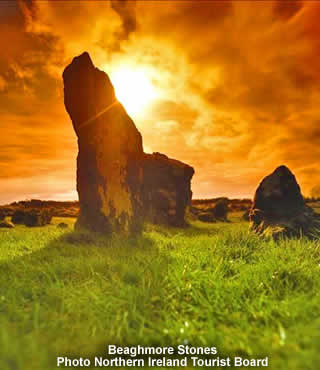 |
|||
Some of the earliest traces of human existence in Northern Ireland |
|||||
|
|||||
Tyrone is the largest of Northern Ireland's 6 counties. It's estimated that people have been living here for nearly 10,000 years. In many parts of the world, traces of such ancient history were erased by either urbanisation, or the destructive power of time. In Tyrone, that's not the case. Its wide-open moors haven't been covered with new towns or cities; they look just the same as they ever did. These untouched locations still bear traces of the people who lived here at the dawn of time. Altogether there are over 1000 standing stones. Many of them have been preserved, so Tyrone's residents and visitors can continue to imagine the lives of their predecessors. |
|||||
One of the most famous sites is at Beaghmore, near Cookstown. The huge complex features 7 stone circles, 10 rows and 12 cairns. Archaeologists think there might be even more that are yet to be revealed. One of the circles is slightly different from the others. To start with, it has slightly larger rocks. More importantly, its interior is filled with over 800 smaller stones, placed upright. They're known as dragon's teeth. The place was only discovered last century, despite being 3500 years old. This suggests that there might be other prehistoric sites out there, just waiting to be found. |
|||||
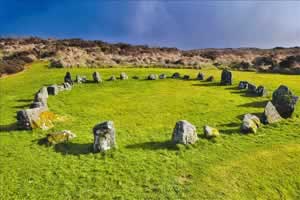 Beaghmore Stones. Photo Northern Ireland Tourist Board |
|||||
An good example is at Copney Hill. This site's uncovered stones are thought to be merely the tip of the iceberg. Experts estimate that the soft ground is hiding up to 6 more monuments. For the time being, visitors have to make do with the visible ones. Sometimes the rocks spread out from a single point, forming lines like the spokes of a wheel. At other times they're in a more familiar circle shape. Some feature the same "dragon's teeth" as those as Beaghmore. Copney Hill is part of a large megalithic landscape that occupies the area just south of the Sperrin mountains. Plenty of other monuments lie between here and the horizon. If you get lucky, you could even discover one yourself. |
|||||
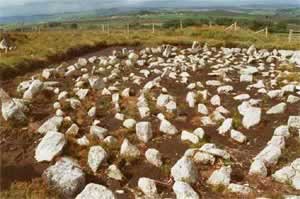 Copney Hill Stones. Photo Northern Ireland Tourist Board |
|||||
Of course, some people might not like the idea of uncovering such creepy relics. Many of them were tombs for the dead. These graves come in several different styles. One is called a court tomb, because of the courtyard-style spaces it's divided into. The best example is at Creggandevesky. Its stone cairn is over 18 metres long. One of the chambers contained objects like arrowheads and a bead necklace. Presumably these possessions were to be taken on to the afterlife. Another chamber contained the bodies. Creggandevesky held 21 in total, which is a very high number. Most court tombs had only 2 or 3. |
|||||
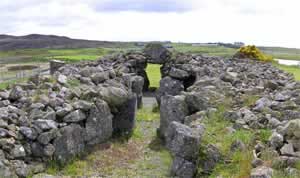 Creggandevesky Court Tomb. Photo Kenneth Allen |
|||||
A second common style of grave is the wedge tomb. They have a tapered shape, like a triangle. A good example is at Loughash. It features a huge roof stone, balanced on top of two pillars. The space created underneath was the burial spot. It's thought that many more roof stones once existed, making this originally a much bigger site than it now appears to be. |
|||||
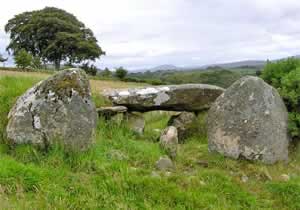 Loughash Tomb. Photo Kenneth Allen |
|||||
These monuments are just a fraction of County Tyrone's vast contents. While lots of them are obviously burial grounds, the purpose of other structures remains unclear. There are dozens of theories floating around, some more plausible than others. Some say they were giant sun dials, used to tell the time. Others say these were religious sites, used to worship the sky, the moon, or some prehistoric god. A relatively practical idea is that they were created by farmers, to encourage the growth of crops. Of course, there's also the possibility that these are mere decorations, arranged as they are simply because they look good. |
|||||
|
|||||
Cookstown Tourist Information Centre, The Burnavon, Burn Road, Cookstown, BT80 8DN. Tel: 028 8676 9949 |
|||||
|
Pocket Britain is optimised for use on a smartphone or tablet with internet access. All content is subject to copyright. All reasonable methods have been used to ensure information supplied is accurate at the time of publication. However, it is advisable to check information before relying on it. Privacy Policy |